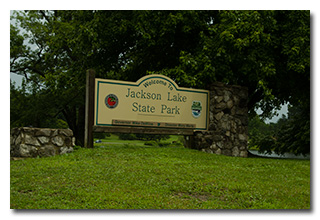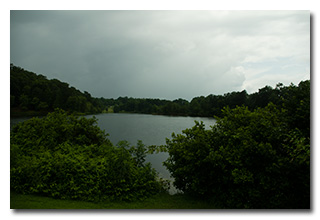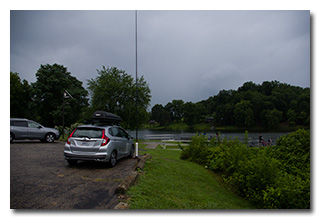
by William Eric McFadden
Support-Your-Parks Summer 2021 RATpedition, Day 1; park six of ten
From the park's website:
-
Although relatively small, 106-acre Jackson Lake State Park boasts some of the most scenic country in Ohio. The park's serene lake is a focal point for excellent fishing and provides the ideal setting for a peaceful retreat.
Pictures
Description
 For the Parks on the Air program (POTA; link) Support Your Parks Summer 2021 Plaque Event
on the weekend of July 17-18, 2021, one member of the Southeast Ohio Radio Adventure Team
performed an aggressive two-day activation schedule with an overnight stop in Portsmouth, Ohio. The route of Eric McFadden, WD8RIF,
would cover over 300 miles, would include fifteen stops in two states, and would lead to twenty-one successful POTA activations with
421 QSOs made. Over the weekend, Eric would encounter rain, thunderstorms, and brilliant sunshine.
For the Parks on the Air program (POTA; link) Support Your Parks Summer 2021 Plaque Event
on the weekend of July 17-18, 2021, one member of the Southeast Ohio Radio Adventure Team
performed an aggressive two-day activation schedule with an overnight stop in Portsmouth, Ohio. The route of Eric McFadden, WD8RIF,
would cover over 300 miles, would include fifteen stops in two states, and would lead to twenty-one successful POTA activations with
421 QSOs made. Over the weekend, Eric would encounter rain, thunderstorms, and brilliant sunshine.
Following a successful activation at Waterloo Wildlife Area (K-8633) (link), a successful two-fer activation of Lake Hope State Park (K-1968) and Zaleski State Forest (K-5455) (link), a successful activation at Lake Alma State Park (K-1967) (link), and a successful activation at Cooper Hollow Wildlife Area (K-8634) (link), Eric's fifth stop of the day was Jackson Lake State Park (K-1962).
 Eric arrived at the Jackson Lake State Park fishing pier at about 1745 UTC and could hear local thunder while he deployed
his 28½' wire vertical on his Jackite 31' telescoping fiberglass mast and drive-on mount. Because of the
very real possibility of rain and thunderstorms, Eric set up his KX3 inside his car. Eric was on the air at 1754 UTC.
Eric arrived at the Jackson Lake State Park fishing pier at about 1745 UTC and could hear local thunder while he deployed
his 28½' wire vertical on his Jackite 31' telescoping fiberglass mast and drive-on mount. Because of the
very real possibility of rain and thunderstorms, Eric set up his KX3 inside his car. Eric was on the air at 1754 UTC.
Before commencing operations, Eric asked his friend K8RAT via text to check the lightning map and tell him where the lightning was relative to Jackson Lake. When Mike told him the lightning was southeast of Jackson Lake, over a portion of the Wayne National Forest—Eric's next destination—Eric thought it was reasonably safe to begin operations so long as he kept watch for closer strikes.
 Eric began operations by finding a frequency to run and by 1814 UTC he had made eleven QSOs.
Eric began operations by finding a frequency to run and by 1814 UTC he had made eleven QSOs.
Pausing to check POTA Spots for P2P QSO opportunities, at 1818 UTC, Eric made a P2P QSO on 30m with KK9JEF who was activating Santa Fe Prairie State Nature Preserve (K-7839) in Illinois.
Finding his own frequency on 30m, Eric made five QSOs by 1829 UTC. This run included a P2P QSO with ND9M who was activating Greenbrier State Park (K-1575) in Maryland. It was during this period that the skies opened in a real gully-washer of a downpour, the noise of the rain being so loud that Eric had trouble hearing the CW in his headphones. There being no evidence of lightning, however, Eric continued to operate as well as he could.
Pausing again to check POTA Spots, at 1834 UTC Eric made a P2P QSO on 20m with N6EF who was activating Folsom Lake State Recreation Area (K-3432) in California. This was followed at 1841 UTC by a P2P QSO on 20m with NG5E who was activating Lake Boeuf Wildlife Management Area (K-4063) in Louisiana, and at 1845 UTC by a P2P QSO on 40m with N1RBD who was activating Chestatee Wildlife Management Area (K-7138) in Georgia.
The rain having stopped, and because his aggressive itinerary didn't allow for much time at any of the parks, Eric tore down his station in order to proceed to his next location.
In all, Eric made twenty QSOs, including five P2P QSOs. All of Eric's QSOs were CW and were made at the 5-watt level.
Eric also submitted his log to the World Wide Flora and Fauna in Amateur Radio (WWFF; link) program.
(return)